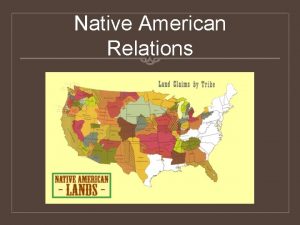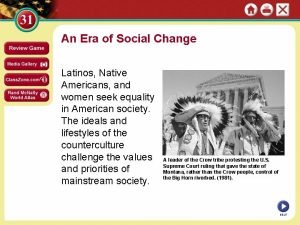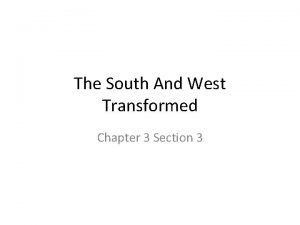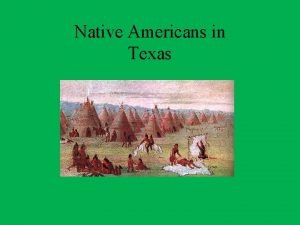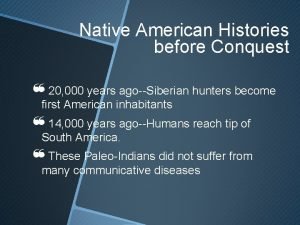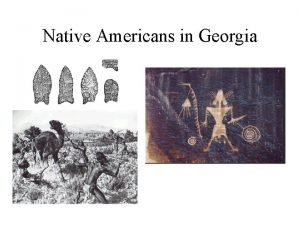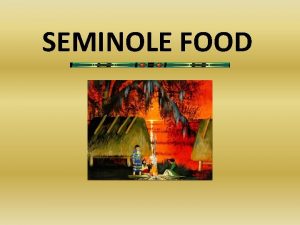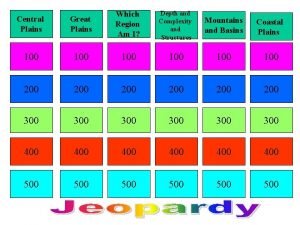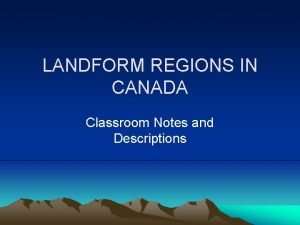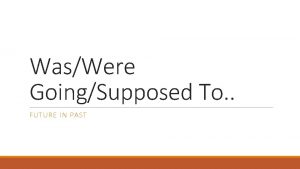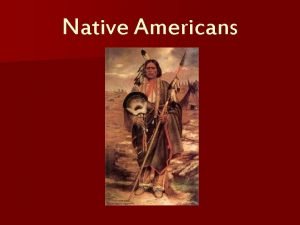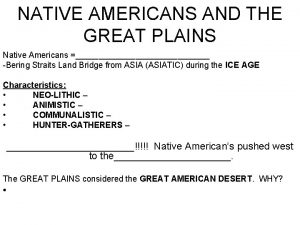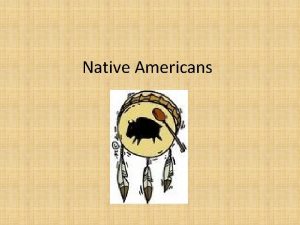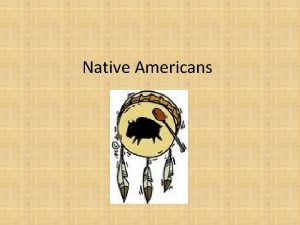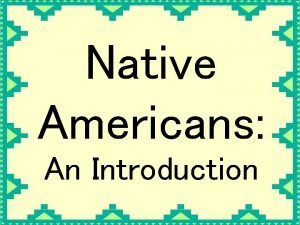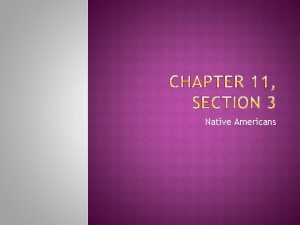Native Americans of the Plains Where Were They










- Slides: 10

Native Americans of the Plains

Where Were They? The plains Native Americans lived in Central America west from the Mississippi River Valley to the Rocky Mountains and north from central Texas to Alberta, Manitoba, and Saskatchewan.

Important Tribes of the Plains Central Plains tribes were the Lakota Sioux, Nakota Sioux, Dakota Sioux, Cheyenne, Arapaho, and the Pawnee. The tribes in the south were the Comanche, Apache, and the Kiowa. Northern tribes were the Mandan, Hidatsa, and the Blackfeet.

Important Leaders of the Plains Sitting Bull- One of the most respected Lakota Sioux. He fought in the battle of Little Bighorn. Eventually he was forced to live on a reservation where he encouraged the other Native Americans to oppose unfair reservation laws. Red Cloud- Young Lakota Sioux war chief who repeatedly lead attacks on three U. S. Army forts. Eventually the army was forced to surrender. Crazy Horse- Lakota Sioux brave, raider, and warrior , he lead his men to victory at the Battle of Little Bighorn. He got his name because in battle he would charge his enemy on his horse, causing them to fall off. Chief Joseph- One of the last chief to surrender, he was driven into Canada where he was forced into surrendering.

Customs and Traditions Peyoteism is a religion developed on the plains in the late 1800’s. The Sun Dance was an important religious ceremony. Lasting 3 -4 days, performers weren’t allowed to have any food or drink. As a result, they got delusional. The dance got its name from a part where dancers circled a huge pole that had been put in the ground. The skin of these dancers had been pierced in the chest. A string had been strung through the hole and tied to the pole. The dancers leaned back and looked at the sun. Eventually the string broke. The Plains Indians felt like this dance allowed them to communicate with the Creator. A sweat lodge was a large dome like structure. Men used it in religious ceremonies. Water was dumped on a fire in the center, creating steam. They thought that sweating cleansed your body and soul.

Vocabulary Chief- A chief was generally an older man who had a great sense of honor, fairness, and wisdom. A chief made the big decisions, like whether to go to war or not, and the small ones, like settling family arguments. A chief also had to see that the wives and children of a dead warrior were taken care of. Nomadic- to move around following food Counting Coup- To get a coup was a great honor. Each person had “coup”. For a warrior to get someone's coup, he had to touch, but not harm, his enemy. It was shameful to have your coup taken. The more coup you had counted, the more respected you were.

The Ghost Dance In 1899 a man named Wovoka founded the religion known as the Ghost Dance. It was very popular. The version of the religion most popularly practiced said that if the Native Americans preformed the Ghost Dance, then all the whites would die. The Indians could then return to their old way of life, which many longed to do. The dancers deceased relatives would also return to life. This scared settlers because rather than seeing how much the Native Americans missed their old lifestyle, they only saw how eager they were to have all of the white people dead.

Accomplishments and Important Events In 1856 The Battle of Little Bighorn was fought between the whites and the Native Americans. Custer led an attack on a group of Lakota and Cheyenne camping at Little Bighorn River. The group killed Custer and his men and drove away all reinforcements. Hunting on horses was really important to the Plains Indians. On horse they could travel faster, hunt more buffalo in all weather, and ensure that they always had enough meat.

More Accomplishments and More Important Events Buffalo Bills Wild West Show spread the idea that Indians were savage and needed to be controlled and tamed. It helped the government gain support from settlers for the armies brutal war. In 1890 the Wounded Knee Massacre occurred. A group of Ghost Dancers were resting along Wounded Knee Creek when they were caught by the Seventh Cavalry. They peacefully surrendered. The next morning when the troops were grabbing their weapons, someone accidentally fired off a shot. The cavalry freaked out and shot all the Native Americans in sight and those fleeing.

Life Today on the Plains The Cherokee tribe as of 1990 had 308, 000 members. The Sioux have 103, 000 members. About 27% of all Native Americans live in poverty, and the average income is $21, 750. Ben Nighthorse Campbell- born 1933, Northern Cheyenne Indian Ben Nighthorse Campbell is a jeweler who combines Japanese and Native American traditions. He is also a distinguished Senator from Montana. Powwows are a gathering where many tribes get together and celebrate their heritage. A Native American who is born in the United States is considered a legal citizen. If they are born to a tribe that the federal government recognizes, then they are also considered a citizen of that tribal nation. Native Americans considers themselves U. S. citizens second, and tribal citizens first.
 How many native americans died on the trail of tears
How many native americans died on the trail of tears Latinos and native americans seek equality
Latinos and native americans seek equality What three circumstances hurt native americans
What three circumstances hurt native americans Coahuiltecan tattoos
Coahuiltecan tattoos Portuguese sailor
Portuguese sailor Where did native americans come from
Where did native americans come from What did the seminoles eat
What did the seminoles eat Central plains center of amarillo, tx
Central plains center of amarillo, tx Landform regions map of canada
Landform regions map of canada The bitter conflict between whites and indians intensified
The bitter conflict between whites and indians intensified Was/were going to future in the past
Was/were going to future in the past
